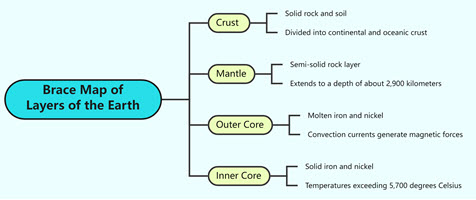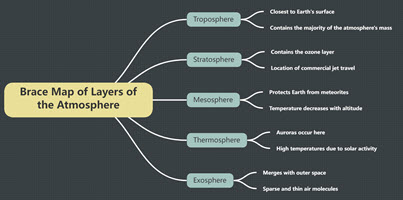In the realm of education, effective tools for organizing and understanding information are essential. One such tool is the Brace Map, a visual learning aid that helps students categorize and dissect information hierarchically. As a part of the Thinking Maps series—comprising eight distinct visual models—Brace Maps are specifically designed to enhance critical thinking skills.
Understanding Brace Maps
A Brace Map serves to illustrate the parts of a whole or the components within a system. At its center lies the main idea or central concept, from which “braces” or branches extend outward, representing various components or subcategories. This visual structure allows students to break down complex topics, fostering a deeper understanding of relationships and encouraging exploration of intricate details in a subject or concept.

For instance, a Brace Map might be used in a biology class to break down the components of an ecosystem. In this case, the ecosystem sits at the center, with branches representing different elements like flora, fauna, and abiotic factors. This clear visual representation aids students in grasping how each part contributes to the whole.
Versatility of Brace Maps in Professional Settings
Beyond educational settings, Brace Maps prove to be versatile tools applicable in various professional contexts. They are particularly effective for:
- Project Planning: Teams can use Brace Maps to outline project components, ensuring everyone understands their roles and responsibilities.
- Process Analysis: Organizations can dissect processes into manageable parts, helping to identify areas for improvement.
- Strategic Decision-Making: Brace Maps facilitate the visualization of options and outcomes, aiding in informed decision-making.
The hierarchical structure of Brace Maps makes them invaluable for individuals and teams seeking to systematically organize information. By enhancing critical thinking and problem-solving capabilities, these maps become essential assets across diverse domains.
Revolutionizing Brace Map Creation for Dynamic Learning
The advent of technology has further transformed how Brace Maps are created and utilized. One notable tool is the Visual Paradigm Smart Board, which offers an innovative platform for designing Brace Maps effortlessly. This digital canvas allows users to:
- Organize Information: Create clear, structured maps that visualize the components of a system or concept.
- Collaborate in Real-Time: Engage with peers or team members, making the map creation process interactive and dynamic.
- Enhance Learning: Utilize Brace Maps for educational purposes, streamlining complex information into accessible formats.
With its user-friendly interface, Visual Paradigm Smart Board makes Brace Map creation accessible to everyone, from educators to professionals. This tool not only simplifies the process but also transforms Brace Maps into dynamic, interactive visual aids that enhance understanding and engagement.
Trace Map Examples
Here are some practical examples of how Brace Maps can be used in various contexts:
1. Educational Example: Ecosystems
Central Concept: Ecosystem
- Branches:
- Biotic Factors:
- Plants
- Animals
- Microorganisms
- Abiotic Factors:
- Water
- Soil
- Climate
- Interactions:
- Food Chains
- Symbiosis
- Competition
- Biotic Factors:
2. Professional Example: Project Planning
Central Concept: Website Development Project
- Branches:
- Planning Phase:
- Research
- Requirements Gathering
- Project Timeline
- Design Phase:
- Wireframes
- UI/UX Design
- Prototyping
- Development Phase:
- Front-end Development
- Back-end Development
- Testing
- Launch Phase:
- Deployment
- Marketing
- User Feedback
- Planning Phase:
3. Personal Example: Healthy Lifestyle
Central Concept: Healthy Lifestyle
- Branches:
- Nutrition:
- Balanced Diet
- Hydration
- Meal Planning
- Exercise:
- Cardio
- Strength Training
- Flexibility
- Mental Well-being:
- Stress Management
- Mindfulness Practices
- Sleep Hygiene
- Nutrition:
4. Business Example: Marketing Strategy
Central Concept: Digital Marketing Strategy
- Branches:
- Social Media Marketing:
- Platforms (Facebook, Instagram, Twitter)
- Content Strategy
- Engagement Tactics
- Email Marketing:
- Newsletter Campaigns
- Targeted Promotions
- A/B Testing
- SEO:
- Keyword Research
- On-page Optimization
- Backlink Strategy
- Social Media Marketing:
5. Science Example: Human Body Systems
Central Concept: Human Body
- Branches:
- Circulatory System:
- Heart
- Blood Vessels
- Blood
- Respiratory System:
- Lungs
- Trachea
- Diaphragm
- Nervous System:
- Brain
- Spinal Cord
- Nerves
- Circulatory System:
These examples illustrate how Brace Maps can effectively organize and categorize information, making complex topics more manageable and comprehensible in various settings.
Conclusion
Brace Maps represent a powerful tool for visual learning, facilitating the breakdown and organization of complex ideas both in educational and professional settings. Their ability to illustrate relationships and components within a whole makes them invaluable for fostering deeper understanding and critical thinking. As technology continues to evolve, tools like Visual Paradigm Smart Board are set to revolutionize how Brace Maps are created and utilized, making learning and information organization more effective and engaging than ever before.

Brace Map of Water Cycle

Brace Map of Layers of the Earth

Brace Map of Human Respiratory System

Brace Map of Structures of a Cell

Brace Map of Layers of the Atmosphere

Brace Map of Stages of Photosynthesis

Brace Map of a Flower

Brace Map of Scientific Method

Brace Map of Life Cycle of a Butterfly

Brace Map of Food Chain in a Forest Ecosystem

